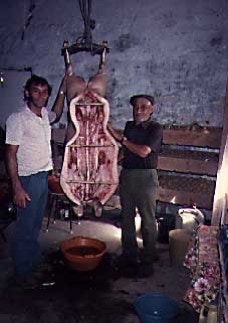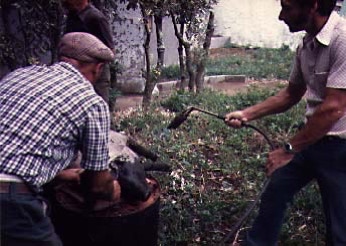Personal stories of Azorean folk customs
Most ethnic groups have their own set of folk customs which are unique to their culture. The people of the Azores have their own customs as well. If you are of Azorean descent, you may remember some of these -- I know I do. I remember as a child, seeing the dance, the Chamarrita, being done at weddings and the Holy Ghost Festival. Sometimes, the adults would let the children participate and that was always great fun. But, even just to watch the adults dance and interact with each other as they danced, was a joy to watch. The memory of it, still brings a smile to my face . . . . after all these years. :)
Of course, the Festival of the Holy Ghost was another custom that I remember from my childhood. Truthfully, I didn't understand it very much back then. I just knew it was like a big party with fireworks, lots of song and dance, linguica and sweet bread. Then, of course, was the culmination of it all on Sunday, with a wonderful parade where all the queens from communities far and wide marched.
Other Azorean customs that I will attempt to give a brief explanation of are the killing of the pig, whale hunting, windmills, and the Azorean guitar. There are many other customs of the people of the Azores that I have not mentioned here. I have attempted to explain only those that I have some limited knowledge or rememberances of. I invite anyone who has stories of folk customs from the Azores that they would like to share, to email me. I would be happy to post them on this site.
The photos included on this page were contributed by Susan Vargas Murphy (Uberlingen@aol.com) from one of her trips to the Azores. Thanks, Susan, for sharing these photos with us!
Chamarrita
Folk songs and dances are very important in most cultures. In the Azores, they were, and still are, an important part of the everyday lives of the people. Music, in all its various forms, is used to express joy, love, sorrow, thanks, and praise. Although there are many songs and many dances, I will describe here only the Chamarrita. This is a dance that is, I believe, popular on all the Azore Islands, but especially so on Faial and Pico. There can be many versions. As the dance has been handed down from generation to generation, and people have moved here and there, they sometimes changed the words. The dance itself, though, is a lively dance done in a circle. There is a caller and he will sing out directions to all the dancers. As I said, there are many different versions of this song, but here are two verses for you to enjoy:
A moda da Chamarrita
Nã tem nada que aprender,
E andar comum pé no ar
E outro no chão a bater. Quero cantar e bailar
Com a moca mais bonita
Bater o pé no terreiro
Dar voltas a Chamarrita
The old Chamarrita dance
Does have little to learn more
Than, lift a foot in the air,
Stamp the other on the floor! I want to sing and dance
Stamp my foot on the ground
Dance with the prettiest gal
In a Chamarrita Round
Killing of the Pig
The pig was an important part of Azorean life. Most, if not all, families would have a pig that, when killed, would provide the family with meat and lard for the entire year. Because the Azores have a harsh climate, the pig could be especially important if crops did not do well or some other catastrophe befell the family. So, the day of the killing of the pig, A Matanca do Porco, is a day to be thankful and joyful that the family would be provided for another year. It was a day when relatives and friends would be invited over to help and also to participate in the celebration. There was much work to be done -- the women did all of the food preparation. There was usually plenty of wine and song to go around.
The actual pig killing was done by a matador, who might be a professional pig killer. Sometimes, though, he was not a professional. I know my husband performed this duty several times at the farm of his grandparents in California. The pig had been fattened up considerably throughout the year and was often so fat, that it could not move easily or quickly. It was captured by some of the men and would have its legs tied. Then, it would be put on a table where, after being cleaned, it would be stabbed in the neck by the matador using a long knife. All the people present, including the children would watch. This may seem pretty gruesome to us now, but not if we remember just what this pig represented to the Azorean people. It represented a successful year to them and the promise that the family would have food in the coming year.
After the killing, there was still a lot of work to do. The hair of the pig needed to be singed off and the skin was scraped. The intestines and organs were removed. The bladder of the pig was sometimes blown up and used as a ball by the children. The intestines were cleaned and used to make either morcelas (blood sausage) or linguica (a meat sausage). Most of the pig ended up being used with not much going to waste. This was always a happy time with much singing and feasting
I'm not really too sure if this is being practiced much in the Azores today. With more modern times and conveniences, this old tradition, may have largely faded out.





